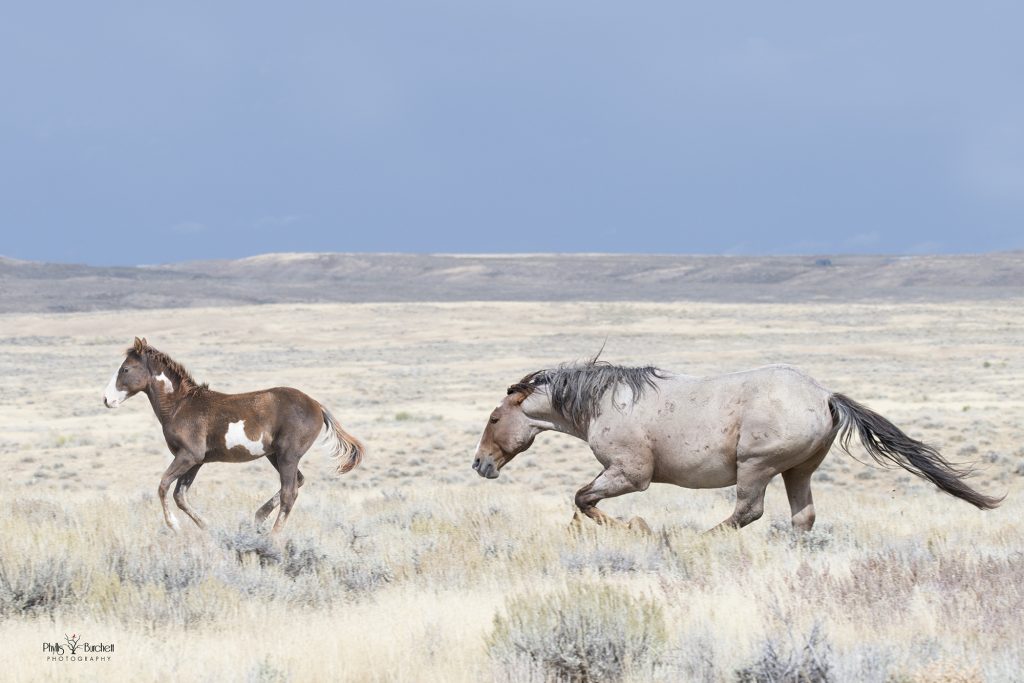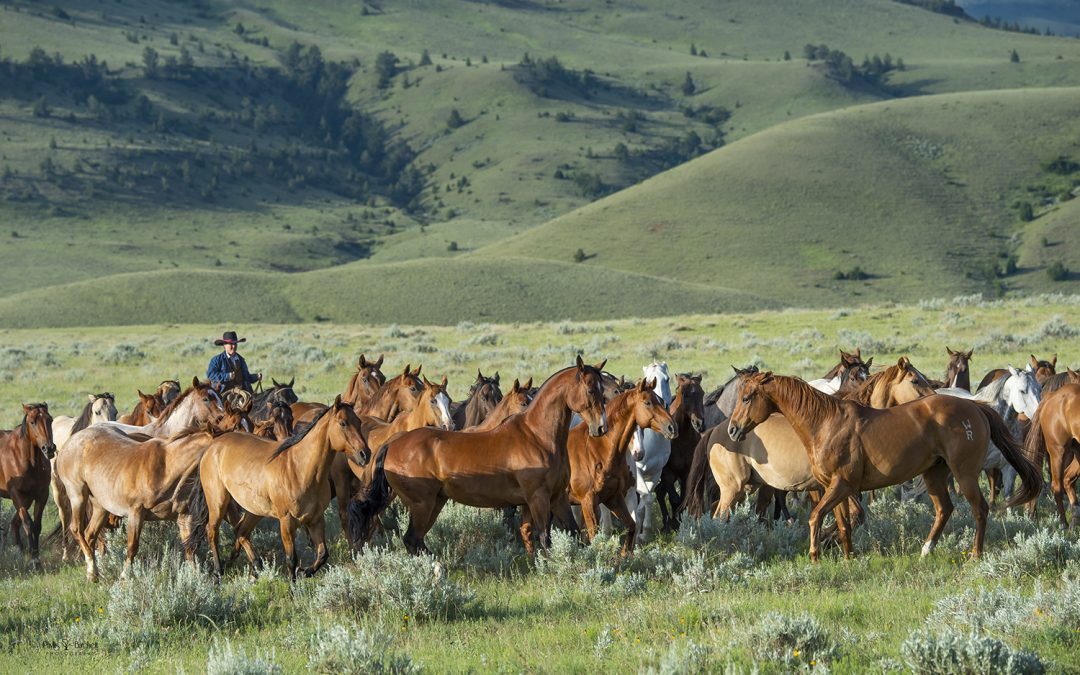Everyone loves to have pictures of horses at liberty, especially in groups, doing what horses do naturally.
 Dryhead Ranch F8 – 1/1000 SS – 500 ISO
Dryhead Ranch F8 – 1/1000 SS – 500 ISO
Capturing horses at liberty can be difficult because in general horses don’t take direction very well. The trick is getting the horse to move through the areas that have the best light and the preferred background. Always think about your backgrounds, separation is key!
When shooting horses at liberty, use an enclosed space – large enough to get the running shots but not too large that you will lose your subject a few fields away! Check to make sure the ground is safe for running (no badger holes!) gates are shut, and fences are in good order. If you’re on a ranch and the landscape is endless, be sure you have experienced and capable wranglers with good control of their equine subjects.
 Powderhorn Ranch F8 – 1/1250 SS – ISO 640
Powderhorn Ranch F8 – 1/1250 SS – ISO 640
First, and most importantly, always consider the safety of the horse and yourself or any helpers you may have on hand. If you are going to pressure horses to move out at liberty, make sure that pressure is gentle, and don’t push them too hard. The best pictures are when the horse is moving in a relaxed manner.
Some of the easiest liberty pictures to set up are when horses have a routine like heading out to pasture in the morning or coming back to the barn at night. Keep shooting until the action stops. Be on the lookout for interaction and interesting behavior between your equine models.
 Cottonwood Ranch F8-1/1250 SS-ISO 800
Cottonwood Ranch F8-1/1250 SS-ISO 800
Make sure to have an idea in your head of what direction you would like the shoot to go in and how you plan to execute it. The more you plan, the more space you give yourself to be creative.
This may seem like a no-brainer, but you’d be surprised how many people ignore it: MAINTAIN A SAFE DISTANCE. Using a long lens will be your best option. This will help to allow the horses to be comfortable enough to move freely as well as to keep you safe.
Shooting from a low angle is a proven method of creating drama in the frame. However, when getting low around horses, take precautions. Be sure you have time and are able to move quickly to get out of the way.
 Sand Wash Basin
Sand Wash Basin
If you’re photographing Wild Horses (and sometimes for domestic ones too) then understanding herd dynamics and behavior is extremely important. Knowing their routine is helpful in finding wild horses, such as when and where they will head to the water. A herd is a complex and often misunderstood family unit. For example, many assume that stallions “lead” a herd, but often it’s a senior or alpha mare who is in charge. The stallion is there for breeding purposes and to defend the family group. Typically, here in the US mares will come into estrus in the spring and summer and, if not pregnant, will cycle several times during the breeding season.
 McCullough Peaks Wild Horses
McCullough Peaks Wild Horses
The herd’s stallion keeps an eye out for small bachelor herds; small groups of younger stallions who want to sneak in and mate with available mares. You should keep an eye out for bachelor herds as well. When they get close, epic fights can break out. You want to be safely out of the way and in the best position to capture these behaviors with your camera.
 Sand Wash Basin
Sand Wash Basin
Pay attention to body language, for instance, head low and ears back. One will see this most often from a stallion who is chasing stragglers back into the herd, this is what we call “snaking”. This head position is aggressive. If you see it directed at you, it is time to back away and give the horse some breathing room.
Because his eyes are on the sides of his head, horses have a 350-degree view, almost four times greater than the range we see. The horse’s visual range stretches from the end of his nose all the way around to an imaginary line extending straight back from his hip.
Horses have two blind spots. A horse cannot see anything directly behind him. But that is not unexpected. A second blind spot may be more surprising, this one exists in front of the horse’s face, from his eye level to the ground below his nose and out to about six feet. He cannot see the grass he grazes, nor the carrot held to his mouth. He uses the whiskers around his mouth to sense these objects.
 Sand Wash Basin
Sand Wash Basin
Horses have excellent peripheral vision.The human brain takes about a half a second to process what our eyes “see”. That processing is not an option for wild horses. They need to note any flicker of movement or change in the environment quickly. Whether the danger is real or not doesn’t matter, there is no advantage to waiting around to find out.
In general, when you’re photographing horses, you want to get good positions for the ears, neck, shoulder, and legs. Choosing the right lens is important, shooting 135mm and higher will produce a natural perspective, free from the distortion caused by using a wide-angle lens. Not to say I may not use a wide-angle lens if I have a beautiful scenic backdrop!
Animals blink, turn their heads, move quickly and unexpectedly, for these reasons and because I don’t want to miss anything, I keep my camera set to burst mode. This will allow me to take multiple photographs in a row while pressing down on the shutter.
 Cottonwood Ranch, Nevada
Cottonwood Ranch, Nevada
Often the horses will be on different planes when running toward us, so we want to have control over which horse we focus on. If you were to lock on to one of the horses towards the back of the pack it is very likely that the horse in the front, the leading horse, or horses, will be out of focus. Of course, this also depends on which F stop you are using and how much depth of field you have. You do not want the lead horse to be out of focus.
Camera Settings – Use at least 1/1000 for shutter speed a second to freeze the action. Depth of field, F8 to F 11 are the best apertures to use as this will achieve good depth of field and in-focus results for the front runners of the pack. Using F2.8 or 4, may result in out-of-focus horses towards the middle and back of the pack. This depends on how much the horses are spread out from near too far.
Choose the shooting mode to use: Manual, Aperture Priority, and Shutter Priority. Personally, I prefer shooting in manual mode so I can control all areas including aperture, shutter and ISO. I used to be concerned about raising the ISO too high. Now, with advancements in camera technology and with the help of Topaz DeNoise AI and Sharpen AI, I feel more comfortable setting the ISO to 3200 and above. That means faster shutter speeds are possible even in relatively low light conditions.
Card speed is another factor that you want to pay attention to and will also affect the speed at which your photos go from the buffer to the card. You want to use cards with fast read/write speeds, you also want cards big enough so that you don’t have to worry about filling them up.
Keep in mind, the image is not finished until you’ve completed your post processing. Not to fix mistakes, but to strengthen composition. Be sure you are shooting RAW files to ensure they have as much data as possible.
 McCullough Peaks Wild Horses
McCullough Peaks Wild Horses


Excellent photo tips acquired,without a doubt,from countless encounters in the field with our hoofed friends!!! Truly,enthralling angles are presented which would be difficult to achieve otherwise!!!SUPERB WORK!!!
Thanks so very much for the lovely comments, hope you’ll join us one day!